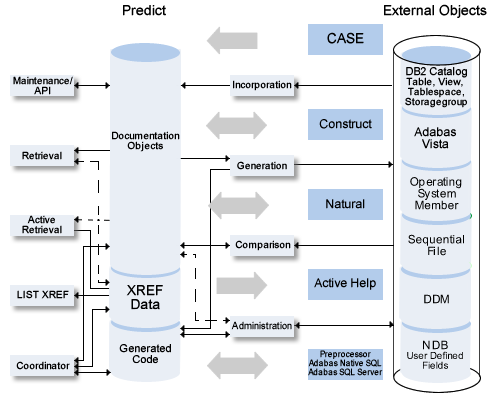
This diagram provides an overview of the functions available in Predict.
Some functions, for example Retrieval, only process dictionary data. Other functions, for example Administration, process dictionary data and objects in an external environment.
This document covers the following topics:
The following diagrams show the predefined metastructure of the Predict documentation data.
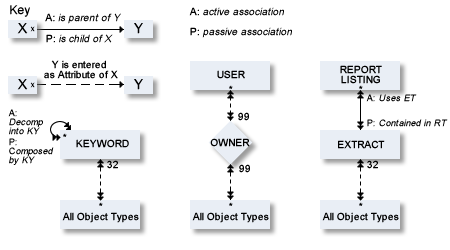
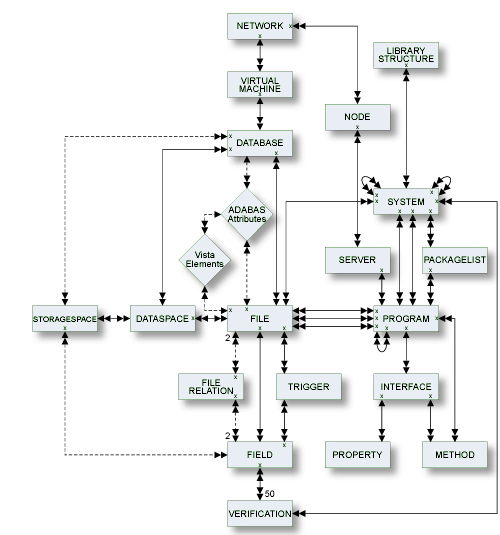
Predict object types can be grouped as follows:
Predict objects can have subtypes. For example: the Predict object type System has the subtypes Application, Conceptual, 3GL application and DB2 plan. These subtypes of system objects are referred to as system types.
The different types of objects and their subtypes are described in detail in the documentation Predefined Object Types in Predict.
Objects of an information processing system are organized in parent-child associations.
Associations of objects can be established
by entering one object in the child list of another object or
by entering the parent of an object in the parameter in parent of the child object (where in parent is to be substituted by the respective association, for example contained in DA). In this case, an entry in the child list of the parent object is created automatically.
The file object DEF_1 can be linked as child to Database ABC_1 by adding DEF_1 to the contains FI list of ABC_1.
Alternatively, ABC_1 can be specified as parameter contained in DA when adding or maintaining the file DEF_1.
New types of associations can be defined to link object types.
See User-Defined Object Types and Association Types.
Different objects of an information processing system having the same properties can be related logically in Predict in one of the following ways:
By assigning the same owner to objects, for example by assigning the owner Junior to all the performance-critical programs written by Mr. Junior.
See Users/Owners for more information.
By assigning the same keyword to objects, for example by assigning a keyword performance_critical to programs.
See Keywords.
By using the same text string in the abstracts or descriptions of objects, for example by using performance_critical in the abstract of programs or by using this string in the description of programs.
See Restrictions.
By placing objects in an extract. An extract can contain an unlimited number of other objects. Full retrieval functionality is available for creating extracts, and existing extracts can be processed with set operations Union, Difference, Intersection.
See the section Extracts.
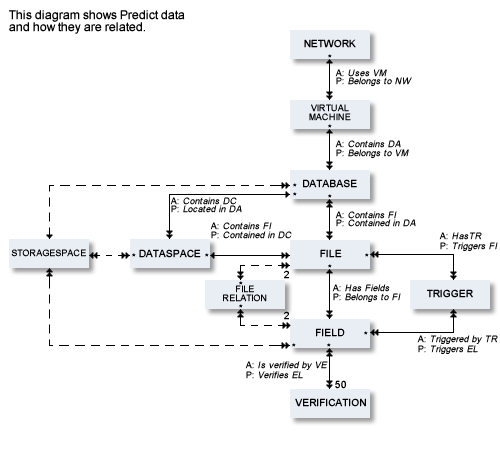
| Object Type | Description |
|---|---|
| Network | All databases belonging to the same network can be accessed. Virtual machines are linked to networks and databases are linked to virtual machines. |
| Virtual machine | The Predict object virtual machine identifies the hardware and operating system environment of a database. |
| Database | Various subtypes are provided to document different database systems. The subtype Conceptual can be used to create preliminary Database objects in the design phase. |
| File |
Over two dozen different file types (including userviews) are provided for documenting different data storage systems and application development environments. Different types of files are distinguished:
|
| Field | Field objects can contain all the information on
attributes and characteristics of fields. If Verifications of type automatic are linked to a field via is verified by VE, these are used automatically in Natural maps which use the field. Fields can be redefined, structured in groups, have synonyms etc. |
| File relation | Coupling of Adabas files and referential integrity of DB2 tables can be documented in Predict with objects of type File relation. |
| Dataspace | For the documentation of DB2 tablespaces and SQL dbspaces. |
| Storagespace | For the documentation of DB2 storagegroups. |
| Verification | Objects of type verification can contain the Natural code for processing rules. Verifications can be of type documented, conceptual, free, automatic, Natural Construct or SQL. Verifications of type automatic are used automatically by any Natural program using the field (to which the Verification is linked via verifies EL) in a map. |
| Trigger |
Triggers of several SQL database systems are documented as trigger objects. They can be linked to tables of type DB2, Ingres, Sybase and Informix and to fields of DB2 tables and views. |
Data dictionary objects of the following types are used to describe objects which process data:
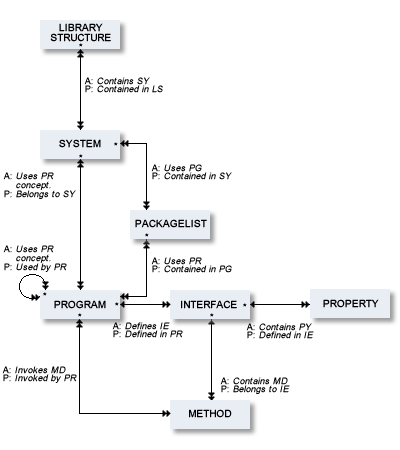
| Object Type | Description |
|---|---|
| System | An application can be documented with a Predict
object of type system. The subtype Conceptual can be used to outline a
preliminary description of an application in the design phase. Libraries of 3GL programs must be specified as systems. |
| Packagelist | The Predict object type packagelist is used to document DB2 packages. |
| Program | Predict differentiates between more than a dozen
different types of programs, ranging from Parameter data area to Natural Expert
Model. About a dozen different languages are predefined and user-specific languages can be defined. |
| Interface | Used to document the interfaces of a class. |
| Method | Used to document the methods of an interface. |
| Property | Used to document the properties of an interface. |
Information on users and organizational units can be documented using the Predict object type user.
Attributes of the Predict object type user include: ID, name, organizational affiliation, address. One attribute of the Predict object type user is owner. Groups of users that reflect organizational units (for example project teams) can be formed by assigning individual users to an owner. Each user can belong to several owners. Owners can be linked to other types of Predict objects.
It is possible to document who uses an information processing object or is responsible for it by adding an owner to the Owner list of the User and then adding the same owner to the Owner list of the object. This is illustrated in the diagram below. The user Levi-Strauss is related logically to the system Blue, because both the Owner lists of the system object Blue and the User object Levi-Strauss contain the owner Team_2.
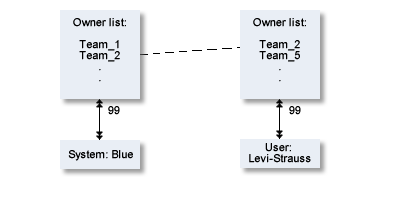
Keywords can be used to relate objects logically (for example all objects used in a particular business context or all objects that share certain properties). Objects of different types can be related using keywords.
The use of keywords to relate objects is illustrated in the following diagram. The program objects SCAN_DESC and REGENER_SYS both have the keyword PERF_CRITICAL in their keyword list.
Predict functions could then be applied to all objects considered performance-critical by specifying the value PERF_CRITICAL with the selection parameter Restrictions / with keyword.
Up to 32 keywords can be assigned to each data dictionary object.
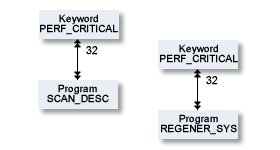
Note:
A keyword must have been defined as a Predict object before
it can be assigned to other objects.
Objects of type extract are used to group objects. This is in particular needed if you want to export objects from Predict using the Predict Coordinator.
Report Listings are log files created automatically during conversion or when a transfer operation of the Predict Coordinator takes place.
In addition to the object and association types delivered with Predict, new object and association types can be defined by data dictionary administrators.
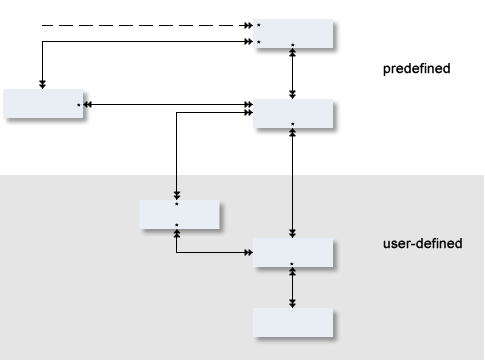
User-defined object types and associations are supported by Predict in the following ways:
They are administered in a separate library.
Standard maintenance and retrieval functions can also be applied to objects of user-defined types.
If the definition of a user-defined object type is changed in the Metadata Administration, all objects are changed accordingly.
See the section Metadata Administration in the Predict Administration documentation for a description of how user-defined object types and associations are created.